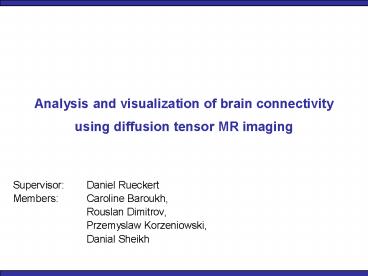Analysis and visualization of brain connectivity using diffusion tensor MR imaging
Title:
Analysis and visualization of brain connectivity using diffusion tensor MR imaging
Description:
Analysis and visualization of brain connectivity using diffusion tensor MR imaging Supervisor: Daniel Rueckert Members: Caroline Baroukh, Rouslan Dimitrov, –
Number of Views:86
Avg rating:3.0/5.0
Title: Analysis and visualization of brain connectivity using diffusion tensor MR imaging
1
Analysis and visualization of brain connectivity
using diffusion tensor MR imaging
- Supervisor Daniel Rueckert
- Members Caroline Baroukh,
- Rouslan Dimitrov,
- Przemyslaw Korzeniowski,
- Danial Sheikh
2
Introduction
- Multiple MRI scans provide 3D voxel grid
- Changing MRI polarizations yields slightly
different results based on tissue orientation - Diffusion tensor imaging (DTI) exploits this to
assign anisotropy tensors to voxels
3
Introduction
- After processing,
- where
- e - major axis of anisotropy ellipsoid
- fa - fractional anisotropy 01
- Pv - voxel center
- Idea use ellipsoids to trace curves (connecting
fibers) in the brain!
Pv
4
Outline
- Aim of the project
- Overview of the application
- Tracing algorithm
- GUI
- Demo
- Group organization
5
Aim of the project
6
Aim of the project
- Application that interactively traces and
visualizes fibers - Regions of interest (ROIs) used as starting point
of fibers - ROIs loaded from a segmentation file or defined
manually - Provide typical medical imaging visualization
(eg. cutting planes, glyphs, etc)
7
(Technical) Overview of the application
- Application in JAVA
- Developed from scratch
- Various toolboxes interactive 3D display
- Tracer in C
- Extends VTK
- 2 new filters
- vtkFiberTracer and vtkInterpolatedDifTensors
8
Tracer
- Input
- DTI data (eigenvector and fractional anisotropy)
- Fiber Seed points
- Output
- Fibers as polylines (connected series of line
segments).
9
Tracer
- for each seedpoint
- f new fiber polyline
- do
- move in direction of anisotropy to P
- f.AddPoint(P)
- until numberOfSteps exceeded
- store f
Use custom second order curvature-preserving
integrator
?
Seed
10
Tracer
- for each seedpoint
- f new fiber polyline
- do
- move in direction of anisotropy to P
- f.AddPoint(P)
- if(fractional anisotrpy lt fThresh)
- break
- until numberOfSteps exceeded
- store f
Empirically fThresh 0.2
11
Tracer
- MRI provides low resolution scans 1283
- Need to use steps much smaller than the voxel
size - Use bilinear interpolation from 8 closest voxel
centers - Danger 3000 fibers 100 steps 8 samples n,
- where n is the order of the integrator, can be
high!
12
Tracer
- Problem 30 of the voxels contain at least two
different neural tracts traveling in different
directions - Solution
- Add inertia to the fiber, so that low anisotropy
regions cannot change its direction
13
vtkInterpolatedDifTensors
- Problem Which way to go?
- Anisotropy ellipsoids have no direction!
14
vtkInterpolatedDifTensors
- Solution
- Flip vectors on the fly
- This needs sense of direction
- Recover it from previous look-up
- Implemented in vtkInterpolatedDifTensors,
inherits interface from vtkInterpolatedVectorField
15
Tracer
- Parameters exposed in the GUI from the Streamline
Panel - Tracing from anatomical ROIs is done by randomly
scattering points within them - Tracing from a user selected sphere distributes
the seeds on the surface
16
GUI overview Demo
17
Questions?































